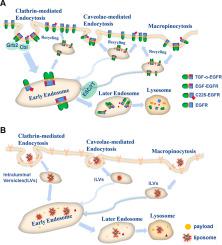Journal of Controlled Release ( IF 10.5 ) Pub Date : 2022-07-22 , DOI: 10.1016/j.jconrel.2022.07.018 Tang Hailing 1 , Pan Yonghong 2 , Zhang Yufeng 2 , Tang Haitao 3

|
Abnormal regulation of cell signaling pathways on cell survival, proliferation and migration contributes to the development of malignant tumors. Among them, epidermal growth factor receptor (EGFR) is one of the most important biomarkers in many types of malignant solid tumors. Its over-expression and mutation status can be served as a biomarker to identify patients who can be benifit from EGFR tyrosine kinase inhibitors and anti-EGFR monocloncal antibody (mAb) therapy. For decades, researches on EGFR targeted ligands were actively carried out to identify potent candidates for cancer therapy. An ideal EGFR ligand can competitively inhibit the binding of endogenous growth factor, such as epidermal growth factor (EGF) and transforming growth factor-α(TGF-α) to EGFR, thus block EGFR signaling pathway and downregulate EGFR expression. Alternatively, conjugation of EGFR ligands on drug delivery systems (DDS) can facilitate targeting delivery of therapeutics or diagnostic agents to EGFR over-expression tumors via EGFR-mediated endocytosis. GE11 peptide is one of the potent EGFR ligand screened from a phage display peptide library. It is a dodecapeptide that can specifically binds to EGFR with high affinity and selectivity. GE11 has been widely used in the diagnosis and targeted delivery of drugs for radiotherapy, genetherapy and chemotherpy against EGFR positive tumors. In this review, the critical factors affecting the in vivo and in vitro targeting performance of GE11 peptide, including ligand-receptor intermolecular force, linker bond properties and physiochemical properties of carrier materials, are detailedly interpreted. This review provides a valuable vision for the rational design and optimization of GE11-based active targeting strategies for cancer treatment, and it will promote the translation studies of GE11 from lab research to clinical application.
中文翻译:

EGFR靶向肽GE11在肿瘤诊断和治疗中的应用面临的挑战
细胞信号通路对细胞存活、增殖和迁移的异常调控有助于恶性肿瘤的发展。其中,表皮生长因子受体(EGFR)是多种恶性实体瘤中最重要的生物标志物之一。其过表达和突变状态可作为生物标志物来识别可受益于 EGFR 酪氨酸激酶抑制剂和抗 EGFR 单克隆抗体 (mAb) 治疗的患者。几十年来,积极开展针对 EGFR 靶向配体的研究,以确定癌症治疗的有效候选者。理想的EGFR配体可以竞争性抑制内源性生长因子的结合,如表皮生长因子(EGF)和转化生长因子-α(TGF- α )) 作用于 EGFR,从而阻断 EGFR 信号通路并下调 EGFR 表达。或者,在药物递送系统 (DDS) 上偶联 EGFR 配体可以促进通过 EGFR 介导的内吞作用将治疗剂或诊断剂靶向递送至 EGFR 过表达肿瘤。GE11 肽是从噬菌体展示肽库中筛选出来的一种有效的 EGFR 配体。它是一种十二肽,可以高亲和力和选择性地与EGFR特异性结合。GE11已广泛用于EGFR阳性肿瘤的放射治疗、基因治疗和化疗药物的诊断和靶向递送。本文综述了影响GE11肽体内外靶向性能的关键因素,包括配体-受体分子间作用力、接头键合性质和载体材料的理化性质,进行了详细解读。本综述为基于 GE11 的癌症治疗主动靶向策略的合理设计和优化提供了宝贵的视野,将推动 GE11 的转化研究从实验室研究到临床应用。











































 京公网安备 11010802027423号
京公网安备 11010802027423号